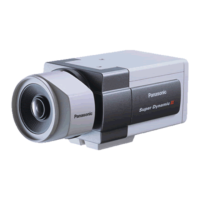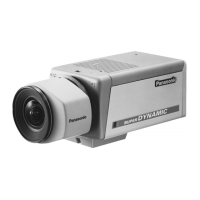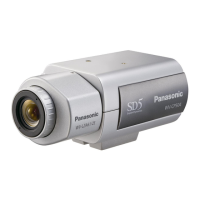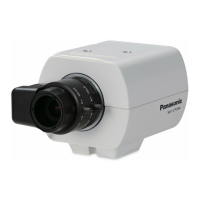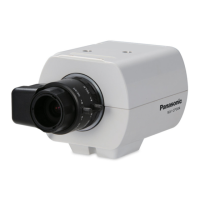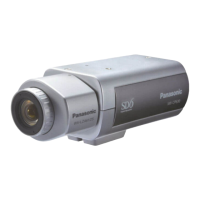Do you have a question about the Panasonic WV-CP410 and is the answer not in the manual?
Covers shock hazards, non-serviceable parts, and mandatory servicing by qualified personnel.
Explains safety symbols, UK fused plugs, fuse replacement, and earthing requirements.
Details on mains lead wiring colours, fuse replacement, and compliance with EC directives and BS standards.
Guidance on handling, environmental limits, sun exposure, and avoiding damage.
Highlights include digital signal processing, low illumination capability, and high SNR.
Details on resolution, detail enhancer, ATW, and dynamic range improvements.
Covers ELC for fixed iris lenses and backlight compensation for challenging lighting.
Diagrams and labels identifying key controls and indicators on the camera.
Details on Lens, Flange-back Adjusting Ring, Connectors, and Sync Selection.
Details on AGC, ELC/ALC, SOFT/SHARP, BLC, ATW, and Lens Type selection switches.
Explanations for ATW Control, Video Level Control, and power input terminals.
Details on Electronic Light Control (ELC) and Back Light Compensation (BLC).
Connecting power supplies for WV-CP410, WV-CP412, and WV-CP414, including cable calculations.
Recommendations for video cable usage and coaxial cable wiring precautions.
Details on focal length, aperture, field of view, and dimensions for various auto iris lenses.
Continued specifications for auto iris lenses, including motorized zoom models.
Further specifications for auto iris lenses, covering wide angle and standard models.
Final specifications for auto iris lenses, including wide angle and standard types.
Specifications for manual and fixed iris lenses, including focal length and filter size.
Procedure for installing the auto iris lens connector, including cutting and soldering.
Steps for mounting auto iris lenses and setting the lens selection switch.
Notes on lens compatibility, weight, and protrusion when mounting lenses.
Procedure for adjusting focus and flange-back, including cautions for service personnel.
Instructions for mounting the camera from the bottom or top using the standard screw size.
Procedure for matching camera video signal phase to AC line phase using an oscilloscope.
Guidance on avoiding image artifacts like smear and blooming when exposed to bright lights.
Steps for cleaning the CCD faceplate and maintaining the camera lens.
Detailed technical parameters of the CCTV cameras, including pick-up device, scanning, and resolution.
Information on power consumption, physical dimensions, weights, standard, and optional accessories.
Covers shock hazards, non-serviceable parts, and mandatory servicing by qualified personnel.
Explains safety symbols, UK fused plugs, fuse replacement, and earthing requirements.
Details on mains lead wiring colours, fuse replacement, and compliance with EC directives and BS standards.
Guidance on handling, environmental limits, sun exposure, and avoiding damage.
Highlights include digital signal processing, low illumination capability, and high SNR.
Details on resolution, detail enhancer, ATW, and dynamic range improvements.
Covers ELC for fixed iris lenses and backlight compensation for challenging lighting.
Diagrams and labels identifying key controls and indicators on the camera.
Details on Lens, Flange-back Adjusting Ring, Connectors, and Sync Selection.
Details on AGC, ELC/ALC, SOFT/SHARP, BLC, ATW, and Lens Type selection switches.
Explanations for ATW Control, Video Level Control, and power input terminals.
Details on Electronic Light Control (ELC) and Back Light Compensation (BLC).
Connecting power supplies for WV-CP410, WV-CP412, and WV-CP414, including cable calculations.
Recommendations for video cable usage and coaxial cable wiring precautions.
Details on focal length, aperture, field of view, and dimensions for various auto iris lenses.
Continued specifications for auto iris lenses, including motorized zoom models.
Further specifications for auto iris lenses, covering wide angle and standard models.
Final specifications for auto iris lenses, including wide angle and standard types.
Specifications for manual and fixed iris lenses, including focal length and filter size.
Procedure for installing the auto iris lens connector, including cutting and soldering.
Steps for mounting auto iris lenses and setting the lens selection switch.
Notes on lens compatibility, weight, and protrusion when mounting lenses.
Procedure for adjusting focus and flange-back, including cautions for service personnel.
Instructions for mounting the camera from the bottom or top using the standard screw size.
Procedure for matching camera video signal phase to AC line phase using an oscilloscope.
Guidance on avoiding image artifacts like smear and blooming when exposed to bright lights.
Steps for cleaning the CCD faceplate and maintaining the camera lens.
Detailed technical parameters of the CCTV cameras, including pick-up device, scanning, and resolution.
Information on power consumption, physical dimensions, weights, standard, and optional accessories.
| Brand | Panasonic |
|---|---|
| Model | WV-CP410 |
| Category | Security Camera |
| Language | English |


